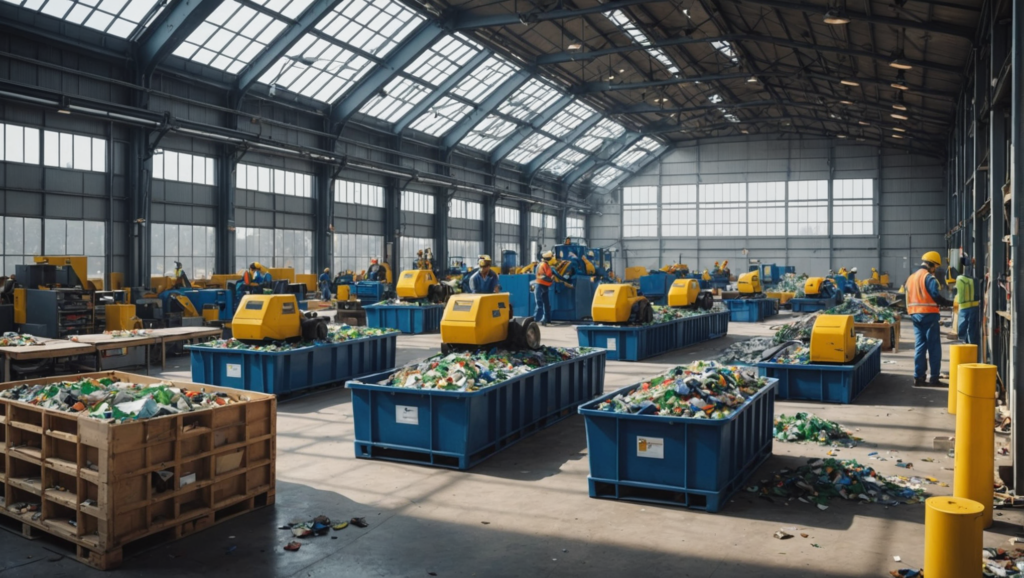Imagine a world where waste is no longer a fatality but a true source of opportunities. The circular economy is aligned with this vision of a sustainable future, where every waste becomes a valuable resource. This innovative model not only aims to reduce resource consumption but to completely rethink our way of creating, consuming, and managing what we consider waste.
Businesses play a central role in this transition to a virtuous model. By adopting sustainable practices, they are able to transform waste into reusable raw materials, thereby minimizing their carbon footprint while maximizing their profits. This approach not only helps to reduce costs associated with waste disposal but also improves brand image and opens up new business avenues.
The concrete actions taken by businesses to integrate the circular economy into their strategy reveal immense potential for innovation, creativity, and social responsibility. So, how can businesses effectively embark on this journey that combines economic performance and respect for our planet?

The challenge of the circular economy presents itself as a response to the growing environmental challenges. This approach aims to rethink how businesses manage resources and waste. Instead of viewing waste as an end, the circular economy encourages businesses to see it as a potential source of value. Indeed, it is possible to transform these residues into true sustainable business opportunities.
Rethinking Waste: A Necessary Transformation
Waste, whether it is end-of-life products or production leftovers, represents a strategic resource that many companies are starting to explore. According to a recent survey by ADEME, the majority of companies in France declare their intention to integrate circular economy practices. In 2022, over 65% of leaders stated that this transition could improve both their efficiency and their reputation in the market.
Some sectors, such as food and textiles, have even recorded significant savings by adopting circular practices. For example, companies like Mango Materials have committed to transforming methane into biodegradable plastics. This type of implementation demonstrates how advanced recycling processes can generate not only financial savings but also significant environmental benefits.
Practical Examples and Case Studies: Inspiring Companies
The Swedish giant IKEA has taken a bold stance for the circular economy. By committing to become a fully circular company by 2030, IKEA is establishing return and resale systems for its used furniture, thereby allowing them to be repaired, renewed, or recycled. This business model is not just a sustainability strategy; it is also economical, limiting raw material costs while responding to increased consumer demand for more virtuous practices.

Another notable example is Unilever, which has managed to create packaging made from plastic waste. By collaborating with recycling companies and innovative start-ups, Unilever has opened a new market: that of sustainable packaging. The result? A significant reduction in material costs, a decrease in their carbon footprint, and an improved brand image. This model has also strengthened their commitment to sustainability, fostering unprecedented customer loyalty.
Strategies for a Successful Transition to the Circular Economy
For companies wishing to integrate the circular economy, several strategies present themselves as effective levers. First, it is crucial to evaluate the entire value chain. This analysis allows for the identification of waste points and opportunities for material reuse. For example, companies can consider the valorization of waste through recycling or reuse, thereby minimizing production costs.
Emerging technologies represent another strategic focus. Industry 4.0, with its advancements in digitalization and automation, allows for the optimization of production flows. Solutions such as smart recycling can thus be implemented, and these new approaches make the process more efficient while demystifying waste management.
Finally, involving employees in the circular transition is essential. Raising awareness and training employees helps generate a sustainable corporate culture, where each team member understands and embraces the challenges. Some companies have implemented true participation programs where employees are encouraged to propose ideas for environmental innovation. This stimulates creativity and sustainable development initiatives.
To go further, associations like Dekra provide guidance on how to initiate a circular economy strategy, promoting a methodology based on awareness and collective engagement.
For more information on the challenges and steps to follow regarding the circular economy, many resources are available online, such as ADEME, which offers tools and practical guides.
✍️Transition vers une économie circulaire : un bilan contrasté, 4 ans après la loi AGEChttps://t.co/Yt6vlrxdmw pic.twitter.com/eVGrIJ0E3I
— Le Monde du Droit (@lemondedudroit) July 8, 2024
FAQ on the Circular Economy
What is the circular economy? The circular economy is an economic model that aims to produce sustainably by limiting resource consumption, waste, and the production of waste.
How can businesses participate in the circular economy? Businesses can engage by adopting waste reduction and resource reuse practices, allowing them to reduce their carbon footprint.
What are the benefits of the circular economy for businesses? Integrating the circular economy allows businesses to reduce their costs, improve their reputation, and open up new market opportunities.
What are the steps to start a circular economy strategy? The first step is to analyze the entire value chain to understand where improvements can be made.
What are the main objectives of the circular economy regarding waste? The fundamental goal is to completely eliminate the concept of waste by transforming what was considered waste into valuable resources.
How to optimize recycling within the circular economy? This includes optimizing energy flows and industrial processes, often facilitated by advancements in Industry 4.0.
What principles govern the circular economy? The principles include sustainability, reuse, recycling, and valorization of waste to maximize resource utilization.
“`
Articles similaires
Thank you!
We will contact you soon.














